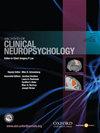A - 49 Predictors of Post-Concussion Anxiety In Patients without Pre-Existing Anxiety History
IF 2.1
4区 心理学
Q2 PSYCHOLOGY
引用次数: 0
Abstract
Identify factors contributing to anxiety in individuals without a pre-existing anxiety history post-concussion. Patients (n = 264, aged 9–68) presented to a specialty concussion clinic post-concussion. They completed a clinical interview, Immediate Post-Concussion Assessment and Cognitive Test (ImPACT), Post-Concussion Symptom Scale (PCSS), Concussion Clinical Profile Screening (CP-Screen), and Vestibular/Ocular-Motor Screening (VOMS). Anxiety group was determined by a positive anxiety/mood clinical profile on CP-Screen. Independent samples t-tests and chi-square tests examined differences in demographics, medical history, and injury characteristics between groups. Univariate logistic regressions (LR) informed a follow-up forward stepwise LR to identify best predictors of post-concussion anxiety group. Receiver operating characteristic (ROC) analysis of the area under the curve (AUC) was used to identify which predictors retained from the LR model best-discriminated anxiety status. Statistical significance was set a priori at p < 0.05. Results of forward stepwise LR identifying factors contributing to post-concussion anxiety were significant (p < 0.001) and accounted for 19% of the variance. The model accurately classified 82.2% of patients, with non-Sport Related Concussion (SRC) (OR = 2.94, 95%CI, 1.45–1.5.98, p = 0.003), history of ADHD/LD (OR = 2.85, 95%CI, 1.21–6.71, p = 0.02), positive vestibular profile (OR = 2.14, 95%CI, 1.06–4.33, p = 0.03), and days to first clinic visit (OR = 1.01, 95%CI, 1.01–1.015, p = 0.003) as significant predictors. ROC analysis of the AUC of this 4-factor model discriminated post-concussion anxiety from no anxiety (AUC, 0.77, 95%CI, 0.71–0.85, p < 0.001). Findings suggest that non-SRC, ADHD/LD history, positive vestibular profile, and delayed clinic visit, may contribute to post-concussion anxiety among patients without prior anxiety history. These predictors may guide clinicians in tailoring interventions to optimize recovery outcomes.A - 49 无焦虑病史患者脑震荡后焦虑的预测因素
确定脑震荡后无焦虑病史的患者产生焦虑的因素。 患者(n = 264,年龄 9-68 岁)在脑震荡后前往脑震荡专科门诊就诊。他们完成了临床访谈、脑震荡后即时评估和认知测试(ImPACT)、脑震荡后症状量表(PCSS)、脑震荡临床特征筛查(CP-Screen)和前庭/眼球运动筛查(VOMS)。焦虑组由 CP-Screen 上的焦虑/情绪临床特征阳性决定。独立样本 t 检验和卡方检验检验了各组之间在人口统计学、病史和损伤特征方面的差异。单变量逻辑回归(LR)为后续的前向逐步 LR 提供了依据,以确定脑震荡后焦虑组的最佳预测因素。曲线下面积(AUC)的接收者操作特征(ROC)分析用于确定从 LR 模型中保留的哪些预测因子最能区分焦虑状态。统计显著性先验设定为 p < 0.05。 前向逐步 LR 确定脑震荡后焦虑的因素的结果具有显著性(p < 0.001),占方差的 19%。该模型对 82.2% 的患者进行了准确分类,其中包括非运动相关脑震荡 (SRC) (OR = 2.94, 95%CI, 1.45-1.5.98, p = 0.003)、ADHD/LD 病史 (OR = 2.85, 95%CI, 1.21-6.71, p = 0.02)。71,p = 0.02)、前庭特征阳性(OR = 2.14,95%CI,1.06-4.33,p = 0.03)和首次就诊天数(OR = 1.01,95%CI,1.01-1.015,p = 0.003)为显著预测因子。对该 4 因子模型的 AUC 进行 ROC 分析后发现,脑震荡后焦虑与无焦虑有明显区别(AUC, 0.77, 95%CI, 0.71-0.85, p < 0.001)。 研究结果表明,非 SRC、ADHD/LD 病史、阳性前庭特征和延迟就诊可能会导致无焦虑病史的患者出现脑震荡后焦虑。这些预测因素可指导临床医生调整干预措施,以优化康复效果。
本文章由计算机程序翻译,如有差异,请以英文原文为准。
求助全文
约1分钟内获得全文
求助全文
来源期刊
CiteScore
4.60
自引率
7.70%
发文量
358
审稿时长
6-12 weeks
期刊介绍:
The journal publishes original contributions dealing with psychological aspects of the etiology, diagnosis, and treatment of disorders arising out of dysfunction of the central nervous system. Archives of Clinical Neuropsychology will also consider manuscripts involving the established principles of the profession of neuropsychology: (a) delivery and evaluation of services, (b) ethical and legal issues, and (c) approaches to education and training. Preference will be given to empirical reports and key reviews. Brief research reports, case studies, and commentaries on published articles (not exceeding two printed pages) will also be considered. At the discretion of the editor, rebuttals to commentaries may be invited. Occasional papers of a theoretical nature will be considered.

 求助内容:
求助内容: 应助结果提醒方式:
应助结果提醒方式:


